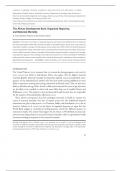Tentamen (uitwerkingen)
The African Development Bank, Organized Hypocrisy, and Maternal Mortality
- Vak
- Instelling
JAMIE M. SOMMER, JOHNM. SHANDRA,MICHAELRESTIVOANDHOLLYE. REED Department of Political Science, Stockholm University; Department of Sociology, State University of NewYorkatStonyBrook;DepartmentofSociology, State University of New York atGeneseo;Departmentof Sociology, Queens College, City Univ...
[Meer zien]




